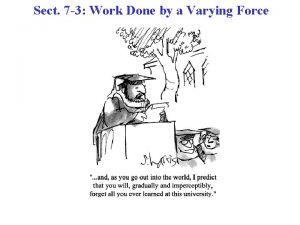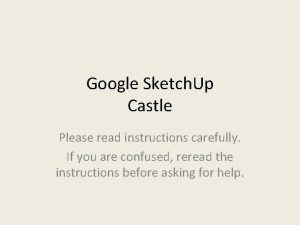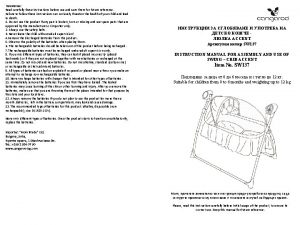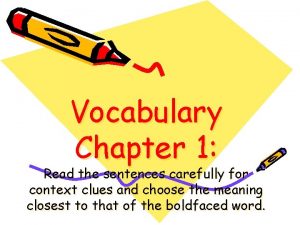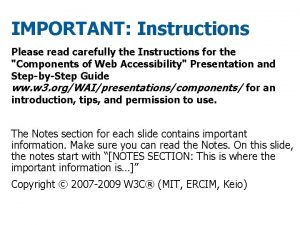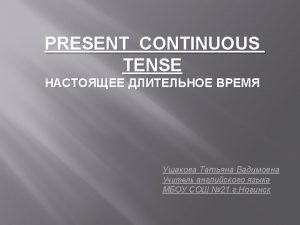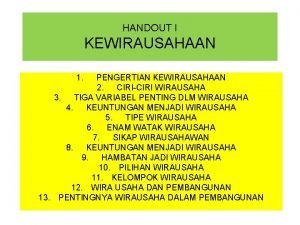Do Now Please read handout on varying theories





































- Slides: 37

Do Now: Please read hand-out on varying theories on human origins

Theories on prehistory and early man constantly change as new evidence comes to light. - Louis Leakey, British paleoanthropologist

Are we all Africans “under the skin”? ? Out of Africa- 1 st homo sapiens emigrated out of Africa Multi-regional-homo erectus left Africa but Evolved in Europe , Asia and Africa Differently



1. 4, 000 BCE – 1, 000 BCE Paleolithic Age: 2. 1, 500, 000 BCE -- 250, 000 BCE 2, 500, 000 BCE to 8, 000 BCE 3. 250, 000 BCE – 30, 000 BCE ( Old Stone Age ) 4. 30, 000 BCE -- 10, 000 BCE

§ “Paleolithic” -->“Old Stone” Age § 2, 500, 000 BCE – 10, 000 BCE § Made tools § hunting ( men ) & gathering (women ) small bands of 20 -30 humans § NOMADIC (moving from place to place)

4, 000 BCE – 1, 000 BCE § Hominids --> any member of the family of two-legged primates that includes all humans. § Australopithecines- AKA “Lucy” §One of the earliest found hominid remains § An Apposable Thumb

§ HOMO HABILIS § created stone tools. ( “Man of Skills” or “handy-man”) § found in East Africa.

§ Humans § Cave during this period found shelter in caves. paintings left behind. Purpose? ?

1, 6000, 000 BCE – 30, 000 BCE § HOMO ERECTUS ( “Upright Human Being” ) Ø BIPEDALISM § Larger and more varied tools --> primitive technology § First hominid to migrate leave Africa for Europe Asia. § First and to use fire ( 500, 000 BCE )

200, 000 BCE – 10, 000 BCE HOMO SAPIENS ( “Wise Human Being” ) Neanderthals ( 200, 000 BCE – 30, 000 BCE ) Cro-Magnons ( 40, 000 BCE – 10, 000 BCE )

NEANDERTHALS: § Neander Valley, Germany (1856) § First humans to bury their dead. § Made clothes from animal skins. § Lived in caves and tents.

NEANDERTHALS Early Hut/Tent

CRO-MAGNONs: § Homo sapiens ( “Wise, wise human” ) § By 30, 000 BCE they replaced Neanderthals. WHY? ? ?


70, 000 BCE – 10, 000 BCE

Characteristics of Paleolithic Period • The people were hunters and gatherers • They lived in small groups of about 20 -30 people • Sexual division of labor(women gathered/men hunted) • Nomadic people who followed game and ripening fruit • Developed simple tools from stone, bone or wood • Invented clothing • Cave paintings and religious rituals

Paleolithic Vocabulary: Changes or Continuities The following vocabulary is based on yesterday’s lesson and homework on the Paleolithic era. In order the major developments of early humans, we will begin the time from about 200, 000 years ago with homo-sapiens ( not Austropithecus Afrencis, Homo Habilis, Homo Erects. Please place the vocabulary word in the changes or continuities category on the opposite side: Bipedalism Fire use Standing upright Religious figurines Hunting and gathering Female gathering Clans of 20 -30 people Development of a complex brain Cave drawings Temporary shelters Burial of the dead Animal skins as clothing Development of a larynx for speech Use of stone and bone tools Humans living in Africa Interaction with the environment Nomadic lifestyle Development of bows, spears and axes Ritualistic war dances Medicines derived from plants Humans lived in Africa Conflict over resources Trade between nomadic groups Food scarcity (not enough) to subsistence (barely adequate) Men and women fairly egalitarian (equal) Small populations

Results: Remember, there is great debate in prehistory( before record keeping/writing) so results may vary. As long as you can justify your argument with evidence and analysis, you can’t be wrong!!!!!!! Continuities Changes Bipedalism Fire use Standing upright Hunting and gathering Clans of 20 -30 people Development of a complex brain Cave drawings Temporary shelters Burial of the dead Animal skins as clothing Humans in Africa Development of larynx for speech Nomadic lifestyle Conflict over resources Scarce and subsistent food supply Men and women fairly egalitarian (equal) Religious figurines Female gathering Development of a complex brain? Burial of the dead? Ritualistic war dances Medicines derived from plants Development of axes

A. D. D For Illustration Friday • To illustrate your knowledge of key Vocabulary, development and continuity and changes ( as well as helping you with the write-draw-explain homework tonight, we will play the trademarked game Act it, draw it, describe it. I will give you one of the terms we have used today and you will: • • Act it- no words but only actions to help illustrate change and continuities Draw it- no words but, rather, pictures and images which help to understand changes and continuities Discuss it- like taboo; you may not use the actually wording but, rather, descriptions of changes and continuities •

COT: Paleolithic • From 2. 5 M. YA- 10, 000 B. C. E early human evelopments included the development of tools from stone and bone, the intoduction of fire for cooking, heat and light, however, mankind maintained its diet primarily based on what could be hunted or gathered


§ “Neolithic” “New Stone” Age § 10, 000 BCE – 4, 000 BCE § Gradual shift from: Nomadic lifestyle settled, stationery lifestyle. Hunting/Gathering agricultural production and domestication of animals.

§ 8, 000 BCE – 5, 000 BCE § Agriculture developed independently in different parts of the world. Ø SLASH-AND-BURN Farming Middle East 8, 000 BCE India 7, 000 BCE Central America 6, 500 BCE China 6, 000 BCE Southeast Asia 5, 000 BCE

? ? Development of Agriculture ? ?

Why do you think the development of agriculture occurred around the same time in several different places?

Why do some archaeologists believe that women were the first farmers?

§ Growing crops on a regular basis made possible the support of larger populations. § More permanent, settled communities emerged. § 9, 000 BCE Earliest Agricultural Settlement at JARMO ( northern Iraq ) wheat

§ 8, 000 BCE Largest Early Settlement at Çatal Hüyük ( Modern Turkey ) 6, 000 inhabitants § 12 cultivated crops § Division of labor § Engaged in trade § Organized religion § Small military An obsidian dagger

Çatal Hüyük

What role did the food supply play in shaping the nomadic life of huntergatherers and the settled life of the farmers?





Advanced Cities Technology Specialized Record- Workers Keeping Complex Institutions
 Will you please be quiet please summary
Will you please be quiet please summary I can't get no satisfaction
I can't get no satisfaction Cobol search varying
Cobol search varying Varied sentence openers
Varied sentence openers Work done by a varying force
Work done by a varying force Varying sentence beginnings
Varying sentence beginnings Equation of continuity for time varying fields
Equation of continuity for time varying fields Varying sentence beginnings
Varying sentence beginnings Varying sentence structure
Varying sentence structure Varied sentence starters
Varied sentence starters Varying sentence structures
Varying sentence structures Current equation
Current equation Cobol perform varying decrement
Cobol perform varying decrement Now i see it now you don't
Now i see it now you don't Please read instructions carefully before use
Please read instructions carefully before use Please read instructions carefully before use
Please read instructions carefully before use Please read carefully the instructions
Please read carefully the instructions Trifon madas death
Trifon madas death Please read our
Please read our Please read the instructions carefully
Please read the instructions carefully Please read the sentences carefully
Please read the sentences carefully Please read carefully the instructions
Please read carefully the instructions Read aloud the following sentences
Read aloud the following sentences Please read
Please read Please read carefully the instructions
Please read carefully the instructions Present continuous reading
Present continuous reading Kids read now
Kids read now Handout 5-2 graphic organizer the brain answers
Handout 5-2 graphic organizer the brain answers Wise mind handout
Wise mind handout Ted talk compassion fatigue
Ted talk compassion fatigue Cengage learning chapter 7 answers
Cengage learning chapter 7 answers Johari window handout
Johari window handout Wound healing nutrition handout
Wound healing nutrition handout Handout gestalten schule
Handout gestalten schule Spinal precautions blt
Spinal precautions blt Karakteristik handout
Karakteristik handout Ciri-ciri handout
Ciri-ciri handout Cheo constipation handout
Cheo constipation handout




